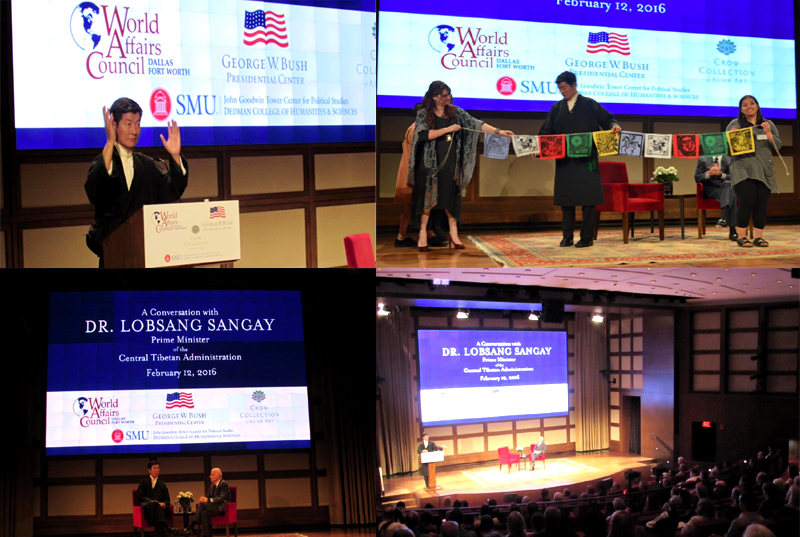 Dallas, Texas, US — Speaking on the geo-political aspect of Tibet at the George W. Bush Presidential Center in Dallas, US, Sikyong Dr Lobsang Sangay said that China's aggressive attitude is further complicating the political situation in Asia.
Dallas, Texas, US — Speaking on the geo-political aspect of Tibet at the George W. Bush Presidential Center in Dallas, US, Sikyong Dr Lobsang Sangay said that China's aggressive attitude is further complicating the political situation in Asia.
The political leader of Tibetans spoke at the prestigious George W. Bush Presidential Center at Dallas on Friday, February 12. He spoke on the topic 'Why Tibet is important for our world'.
The talk was organised by George W. Bush Presidential Center in collaboration with John Goodman Tower Center for Political Studies at Southern Methodist University and Crow Collection of Asian Art.
Describing former US President George W Bush as a good friend of His Holiness the Dalai Lama and the Tibetan people, Sikyong began his talk highlighting the importance of Tibet to the world from an environmental, natural resources and geo-political point of view.
Speaking on the geo-political aspect of Tibet, Dr Sangay proffered that for centuries Tibet has effectively served as a buffer between India and China. However, it all changed after the invasion of Tibet by China, which brought two of the largest populated countries in the world face-to-face, resulting in a serious threat to India's borders.
"This confrontation has led to a military buildup and a rapidly accelerating arms race along the border, according to CIA reports," he said, adding that China's aggressive attitude is further complicating the political situation in Asia.
Sikyong also spoke about the historical independence of Tibet as evidenced by the treaties signed between a sovereign Tibet and China in the earlier centuries. However, he explained that the Central Tibetan Administration, as the leader of the Tibetan movement, seeks genuine autonomy for the Tibetan people based on the Middle Way Approach.
Sikyong expressed optimism at the realistic approach of the policy, which is based on dialogue and non-violence rather than confrontation or complete independence from China.
Summarising his talk at the end, Sikyong concluded that Tibet is central to world affairs given its geographical location, rich untapped natural resources, environmental aspects and, spiritual and cultural soft power.
Comparing Tibet's landmass to that of Western Europe or Texas and California combined, Sikyong spoke about the exploitation of Tibet's rich natural resources by the Chinese government through rampant mining and deforestation.
"Tibet is a huge country by landmass. And as per the Chinese government, Tibet has 132 different kinds of minerals including copper, gold, borax, uranium and a little bit of oil," Sikyong said. "As a result, China refers to Tibet as 'Xizang' meaning 'Western Treasure House' due to its rich untapped natural resources," he explained.
Underlining the environmental significance of Tibet, Sikyong said that Tibet's glaciers are receding at an alarming rate, which could endanger the lives of hundreds of millions of people. "Even from an environmental point of view, Tibet is significant to the world as it is the source of Asia's major rivers and is home to the third highest reserve of ice after the two poles," Sikyong asserted.
"The difference between Tibet and the two poles is that, while the water from the melting of ice on the poles goes to the ocean, the melting of Tibet's glaciers feed the rivers on which more than a million people depend for livelihood," Sikyong added. On that note, Sikyong recalled a prediction made recently by environmental analysts prophesising that future wars could be fought over water resources just as current wars are being fought over energy and past wars over land.
Further emphasising the significance of the Tibetan plateau, Sikyong highlighted that China has 19% of the world population, but only 11 to 12% of freshwater, meaning 7 to 8% of China's population, equivalent to about 400 million people, particularly in north and northeast of China, are facing severe scarcity of fresh water which could prompt China to diversify Tibet's rivers leading to severe hardships caused by water woes in downstream countries like Bangladesh and India where the situation is even worse.
"What is even more alarming," Sikyong added, "is that almost 50% of the ice reserves and glaciers on the Himalayan and Tibetan plateau has already melted in the last few decades. And as far as NASA is concerned, by 2050, another 50% of the Tibetan glaciers will melt."
The talk was attended by Amanda Schnetser, Director of Human Freedom and David Schnetzer, Holly Kuzmich, Dina Rooney, Matt Rooney from the George Bush Institute; Jim Falk, CEO of World Affairs Council, Terrell Falk and Cyrena Nolan from World Affairs Council, and Amy Holland, June Rule, Stacie Adams, Harian Crow, Anne Raymond, Rob Raymond from Crow Collection.
The George W. Bush Presidential Center is home to the Presidential Library and Museum of former US President George W. Bush as well as the Bush Policy Institute and the offices of the Bush Foundation.


![Tibet has a rich history as a sovereign nation until the 1950s when it was invaded by China. [Photo: File]](/images/stories/Pics-2024/March/Tibet-Nation-1940s.jpg#joomlaImage://local-images/stories/Pics-2024/March/Tibet-Nation-1940s.jpg?width=1489&height=878)















